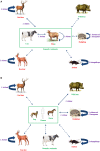Opening the black box of Anaplasma phagocytophilum diversity: current situation and future perspectives
- PMID: 26322277
- PMCID: PMC4536383
- DOI: 10.3389/fcimb.2015.00061
Opening the black box of Anaplasma phagocytophilum diversity: current situation and future perspectives
Abstract
Anaplasma phagocytophilum is a zoonotic obligate intracellular bacterium known to be transmitted by ticks belonging to the Ixodes persulcatus complex. This bacterium can infect several mammalian species, and is known to cause diseases with variable symptoms in many domestic animals. Specifically, it is the causative agent of tick-borne fever (TBF), a disease of important economic impact in European domestic ruminants, and human granulocytic anaplasmosis (HGA), an emerging zoonotic disease in Asia, USA and Europe. A. phagocytophilum epidemiological cycles are complex and involve different ecotypes, vectors, and mammalian host species. Moreover, the epidemiology of A. phagocytophilum infection differs greatly between Europe and the USA. These different epidemiological contexts are associated with considerable variations in bacterial strains. Until recently, few A. phagocytophilum molecular typing tools were available, generating difficulties in completely elucidating the epidemiological cycles of this bacterium. Over the last few years, many A. phagocytophilum typing techniques have been developed, permitting in-depth epidemiological exploration. Here, we review the current knowledge and future perspectives regarding A. phagocytophilum epidemiology and phylogeny, and then focus on the molecular typing tools available for studying A. phagocytophilum genetic diversity.
Keywords: Anaplasma phagocytophilum; diversity; epidemiology; granulocytic anaplasmosis; phylogeny; tick-borne fever; typing technique.
Figures


Similar articles
-
Genetic variability of Anaplasma phagocytophilum in ticks and voles from Ixodes persulcatus/Ixodes trianguliceps sympatric areas from Western Siberia, Russia.Ticks Tick Borne Dis. 2014 Oct;5(6):854-63. doi: 10.1016/j.ttbdis.2014.07.008. Epub 2014 Aug 8. Ticks Tick Borne Dis. 2014. PMID: 25113979
-
Anaplasma phagocytophilum in ruminants in Europe.Ann N Y Acad Sci. 2006 Oct;1078:446-60. doi: 10.1196/annals.1374.084. Ann N Y Acad Sci. 2006. PMID: 17114753 Review.
-
Asian isolates of Anaplasma phagocytophilum: Multilocus sequence typing.Ticks Tick Borne Dis. 2019 Jun;10(4):775-780. doi: 10.1016/j.ttbdis.2019.03.011. Epub 2019 Mar 18. Ticks Tick Borne Dis. 2019. PMID: 30904539
-
Molecular detection of Anaplasma phagocytophilum in cattle and Ixodes persulcatus ticks.Vet Microbiol. 2011 May 5;149(3-4):504-7. doi: 10.1016/j.vetmic.2010.11.025. Epub 2010 Nov 25. Vet Microbiol. 2011. PMID: 21146335
-
A review on the eco-epidemiology and clinical management of human granulocytic anaplasmosis and its agent in Europe.Parasit Vectors. 2019 Dec 21;12(1):599. doi: 10.1186/s13071-019-3852-6. Parasit Vectors. 2019. PMID: 31864403 Free PMC article. Review.
Cited by
-
Diverse tick-borne microorganisms identified in free-living ungulates in Slovakia.Parasit Vectors. 2018 Sep 3;11(1):495. doi: 10.1186/s13071-018-3068-1. Parasit Vectors. 2018. PMID: 30176908 Free PMC article.
-
Rickettsiales Occurrence and Co-occurrence in Ixodes ricinus Ticks in Natural and Urban Areas.Microb Ecol. 2019 May;77(4):890-904. doi: 10.1007/s00248-018-1269-y. Epub 2018 Oct 16. Microb Ecol. 2019. PMID: 30327827 Free PMC article.
-
Host-pathogen associations revealed by genotyping of European strains of Anaplasma phagocytophilum to describe natural endemic cycles.Parasit Vectors. 2023 Aug 16;16(1):289. doi: 10.1186/s13071-023-05900-3. Parasit Vectors. 2023. PMID: 37587504 Free PMC article.
-
Ticks and associated pathogens in camels (Camelus dromedarius) from Riyadh Province, Saudi Arabia.Parasit Vectors. 2020 Feb 28;13(1):110. doi: 10.1186/s13071-020-3973-y. Parasit Vectors. 2020. PMID: 32111251 Free PMC article.
-
Molecular survey of tick-borne infectious agents in cricetid rodents (Rodentia: Cricetidae) in Central and Southern Chile.Front Vet Sci. 2024 May 17;11:1399783. doi: 10.3389/fvets.2024.1399783. eCollection 2024. Front Vet Sci. 2024. PMID: 38828369 Free PMC article.
References
-
- Adams D., Jajosky R., Ajani U., Kriseman J., Sharp P., Onweh D., et al. (2014). Morbidity Mortality Weekly Report Summary of Notifiable Diseases. Available online at: http://www.cdc.gov/mmwr/pdf/wk/mm6153.pdf (Accessed July 21, 2015).
-
- Alberti A., Zobba R., Chessa B., Addis M. F., Sparagano O., Pinna Parpaglia M. L., et al. . (2005). Equine and canine Anaplasma phagocytophilum strains isolated on the Island of Sardinia (Italy) are phylogenetically related to pathogenic strains from the United States. Appl. Environ. Microbiol. 71, 6418–6422. 10.1128/AEM.71.10.6418-6422.2005 - DOI - PMC - PubMed
Publication types
MeSH terms
LinkOut - more resources
Full Text Sources
Other Literature Sources

